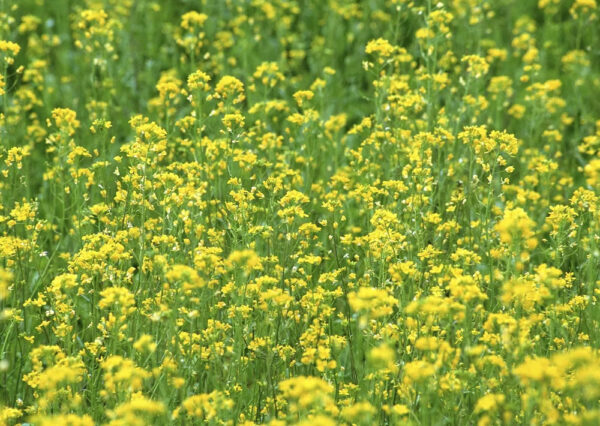On October 26th, 2022, the Genetic Engineering Appraisal Committee (GEAC), India’s biotech regulator under the Ministry of Environment, Forests and Climate Change, recommended the “environmental release” of genetically modified (GM) or transgenic hybrid mustard DMH (Dhara Mustard Hybrid)-11. This paves the way for seed production of this transgenic hybrid, and field demonstration studies of its impact on yields, and environment, and, eventually, for its commercial release subject to favorable results of the impact studies. This development, notwithstanding its ultimate outcome, comes as a great boost to public funded research in agricultural science and technology in general, and the science of genetics and biotechnology in particular, in India. Such research will play the most critical role in achieving a convergence between higher agricultural productivity and better incomes from farming, with a sustainable footprint.
The decision – coming, as it does, after about two decades of India deciding to cultivate genetically modified crops, one-and-half decade of allowing the commercial release of Bollgard II cotton (Bt-Cotton), five years after DMH-11 was first recommended for an environmental release by GEAC, and a few days after Australia’s gene technology regulator released the commercial cultivation of Indian mustard genetically modified for herbicide tolerance – is certainly a cause for hope on multiple accounts.
Science and Technology as a Public Good
To begin with, it is remarkable that DMH-11 has been developed by a team of scientists from Delhi University’s Centre for Genetic Manipulation of Crop Plants (CGMCP) led by Dr Deepak Pental, with support from the National Dairy Development Board (NDDB) and the Department of Biotechnology. In other words, DMH-11 is a product of science driven by the public system of research. Given the increasing concentration of scientific research in the private sector in the field of agriculture and genetic engineering technologies, this is nothing short of an exception.
While research and extension undertaken by national agricultural research systems and international public-access institutions drove the green revolution from the 1960s through the 1980s, research and ownership in the field of biotechnology today has been appropriated, on a vast scale, by multinational corporations. The growing control of agri-business monopolies on genetic technologies, and, by extension, food production systems is one of the important political issues of our time, and one that is of grave concern to farmers’ and rural workers’ movements across the world. (Those interested in reading more about transgenic varieties and political discussions surrounding them, can take a look at the RAS symposium from 2011)
In a sense, therefore, DMH-11 exemplifies a hope for re-appropriation of the definition of scientific research as a public good. Ironically, this development comes in the context of a larger thrust for liberalizing and privatizing agriculture, made apparent by the, now repealed, three farm laws. It, naturally, raises the doubt about this being another step by the neo-liberal Indian state towards, eventually, allowing the entry of big agri-corporates to the field of genetic engineering research in agriculture in India. The fear, although genuine, cannot be the ground to forestall the entry of the promising technology of genetic engineering, that stands at the frontiers of a progressive transformation of agricultural production systems.
Boost to Production
Another cause for hope, of course, is the promise of higher yield and production of mustard, that might be realised if and when DMH-11 is absorbed in production by farmers in India. The average area under mustard cultivation in India hovers somewhere between 6 to 7 million Hectares, while the average annual production over the last 5 years is about 8 million Tonnes. Production has been expanding over the last decade, driven mostly by an increase in yield due to expansion of area under irrigation. However, the average yield of mustard in India, at less than 1500 Kg per hectare, is much lower than that in the developed world, around 2200 to 2500 Kg per hectare. On the other hand, the volume of import of edible oils by India, clearly point to a severe deficit in domestic production.
India imports about 50 to 60 percent of its edible oil requirements. The import of edible oils was about 140 Lakh Tonnes in 2019-20, which included oil from Palm , Soybean, Rapeseed (Canola) and Mustard, Olive, Sunflower, and etc. Interestingly most of Canola and Soybean that is used for oil production is GM, and it would be ironical if we are to import oil from GM Indian Mustard from Australia! Unsurprisingly, our edible oil imports cost us a significant amount of foreign exchange (about $19 Billion in 2021-22, according to newspaper reports). If we just consider Rapeseed and Mustard oil, India’s import was about 4 lakh Tonnes in 2016-17. It came down to about 55,000 Tonnes in 2020-21, but mostly due to raised import duties. This indicates that there is a huge market of mustard and canola oil that cannot be met without quantum increase in domestic yields.
Some experts claim that DMH-11 can boost the yield by 25 to 30 percent, without much increase in use of water, or chemical fertilizers and pesticides. There are others, however, who dispute claims of its yield advantage over some varieties of existing non-GM Mustard. These claims and counter-claims, of course, will have to be verified by the impact studies. However, there is no denial about the much needed increase in yields and production of mustard, a feat that would be difficult to achieve without the use of transgenic technology. It must be appreciated that the technology used to develop DMH-11 is quite old (DMH-11 seeds were ready by 2002), and may not prove to be very high-yielding, but would still continue to form a useful platform from which better yielding GM hybrids can be developed in the future. The relevance of this decision, therefore, goes beyond the immediate yield expansion effect of DMH-11, it lies in opening up the possibility of developing other GM-hybrid mustard with greater yield potential.
Opens the Pathway for More Genetic Research
Significantly, this decision also opens up the possibility for further genetic engineering research towards developing mustard hybrids with other selective traits such as better input efficiency, better product quality, higher pest resistance, to name a few.
The GEAC has also recommended the field trials for GM hybrids of Banana, Cotton, Potato, and Rubber. Public sector research institutions, such as ICAR-Potato Research Centre, National Agri-Food Biotechnology Institute, and Rubber Research Institute of India, are expected to lead these research trials. These steps will hopefully expand the scope of genetic engineering research in agricultural production in India after a long hiatus, a development that will go long way in helping expand agricultural productivity in a sustainable fashion. When developed and disseminated by the State such research can also lead to a positive impact on farm profitability. These developments are indicative of a possible convergence of the goals of higher agricultural productivity and production, better incomes for farmers, and environmental sustainability, that is made possible by appropriate development and deployment of agricultural science and technology under proper State Control.
Concerns regarding Environmental Sustainability
A major criticism of GM crops pertains to the harm that it might cause to ecology, and to human and animal health. The criticism remains strong despite the fact that GM crops have been used, and consumed, for more than two decades now without causing specific harm to any species, or to the ecology in general.
In the specific case of GM-Mustard, it has been argued that it can have adverse impact on the population of pollinators, particularly honey bees. While this is a hypothesis that requires systematic scientific inquiry to arrive at any conclusion, there is not much evidence to support the claim. As a matter of fact, GM-Canola (Canola/Rapeseed and Mustard are different species under the same genus), developed using the same Barnase-Barstar technology that has been used to develop DMH-11, has been cultivated for more than a decade in countries such as Canada, without any remarkable harm to bee colonies. Having said that, it is undoubtedly critical that systematic impact studies of any new technology are thoroughly and scientifically conducted under specific agro-climatic conditions, before it is accepted for production. And this is already part of GEAC’s recommendations. GEAC has instructed the conduct of field studies under the supervision of Indian Council of Agricultural Research (ICAR) to generate evidence of effects of DMH-11 on honeybees and other pollinators in Indian agro-climatic zones within next two years.
Uncertainty is part of any scientific and technological development, and any policy framework dealing with technological developments has to work with some level of uncertainty. A blanket rejection of the technology itself cannot be an answer to all uncertainties, particularly when the technology – genetic engineering, in this case – is critical to a sustainable, and food and nutrition secure future. The way to technological progress requires maneuvering through uncertainty in a manner that is sustainable from the point of view of human development, including environmental sustainability. In the case of genetic engineering this implies the presence of a robust and independent regulatory system, under the aegis of the state. Such a system can help define well-established standards of human safety and environmental sustainability, and ensure that the development of high yielding hybrids through genetic engineering technologies adhere to such standards. Constant monitoring and evaluation by robust regulatory agencies must be an essential aspect of ecosystem of genetic engineering research.
Effects on Employment
Another concern with regard to development and absorption of technology, including transgenic technology, in agricultural production has been regarding its tendency of causing unemployment, and displacing manual work. The concern is one-sided at best. It fails to appreciate that technological development also leads to new kinds of employment, and significant reduction in the drudgery of agricultural tasks. This is not to imply that there would not be any loss of employment by the coming of new technology in agriculture, but rejection of a technology on this premise is naive, at best. The point rather is to account for the loss of employment as the cost of technology, and ensuring those losing out are compensated in a just and fair manner, and have access to better jobs and economic mobility. Research indicates that in any case agriculture in India is not in a situation to absorb the rural work force, and the non-farm sector, particularly manufacturing, has to be strengthened in order to provide meaningful employment. This is of course a macro-economic policy problem, with no easy Luddite-like solution.
In this specific case of GM-Mustard, it has been argued by some that the herbicide tolerance in DMH-11 will lead to expansion in the use of herbicides that will, in turn, take away the manual work of weeding. As a temporary solution, the GEAC recommendation restricts the use of Glyphosate (herbicide) to registered “Pest Control Operators.” The attempt is to prohibit the use of herbicide, except in the production of hybrid seeds of DMH-11. This step may prevent the application of herbicides in the actual production of GM-Mustard by farmers, as and when it begins.
This, of course, is a temporary solution. And one has to think of more permanent ways to deal with the larger issue of technology induced unemployment in agriculture, without taking recourse to a reactionary position of rejecting the technology itself. As a matter of fact, it would not be wrong to argue that with developments in genetic engineering technology the need for herbicide tolerance in developing GM-Hybrids will be reduced, if not eliminated. Such possibilities in genetic engineering, however, can only be explored after the technology is allowed to function, and more public investments are directed towards research in biotechnology.
Concluding Concerns
The approval from GEAC for “environmental release” for DMH-11 implies a horizon, according to experts, of, at least, two years before it becomes available for widespread use and adoption, provided the field trials yield favourable results in terms of yields and safety concerns among other parameters. However, the given the history of slow promotion of genetic engineering research in India, this horizon is marked by uncertainties, and inspires limited confidence.
The uncertainty, it must be said, is not due to the underlying science of genetics which is quite matured as of today. Neither is it arising from democratic decision-making process building on science and rational opposition, based on evidence and arguments. The uncertainty that threatens to become an insurmountable barrier stems from an ideological opposition by some to the application of science and technology to agriculture, and transgenic technology in particular. This opposition mostly draws from ephemeral measures of public opinion, anecdotes, hearsay, and ‘surveys’ characterized by faulty, ignorant, or dishonest methods, and is characteristically immune to empirical disconfirmation. This ideological opposition has infested various shades of the political spectrum in the country, from the right to the left in the country.
DMH-11 is a celebratory achievement of public funded research in India in an adverse landscape. It has the potential to open up the possibility of genetic engineering research in India, which is crucial for increasing production and productivity, and improving food and nutrition security. It is also a reminder of science and technology as a public good, which is essential for better lives and livelihoods for all producers, as well as for national self-sufficiency and sovereignty. The challenge is to ensure such technological developments are welcomed and facilitated, and their overall control by the State, through various policy measures, is maintained.
The author is thankful to Sethu C.A. for his critical inputs.
About the author
Sandipan Baksi is the Director of the Foundation for Agrarian Studies.

















































































